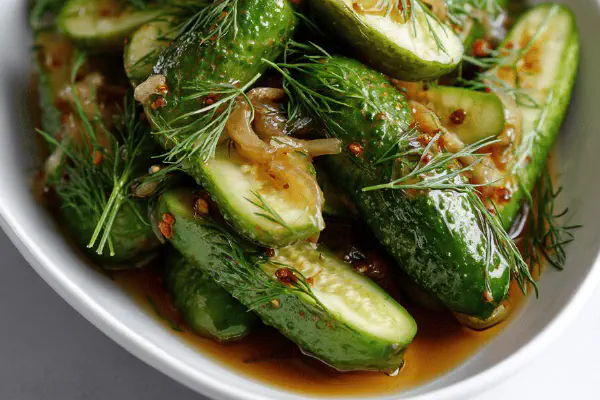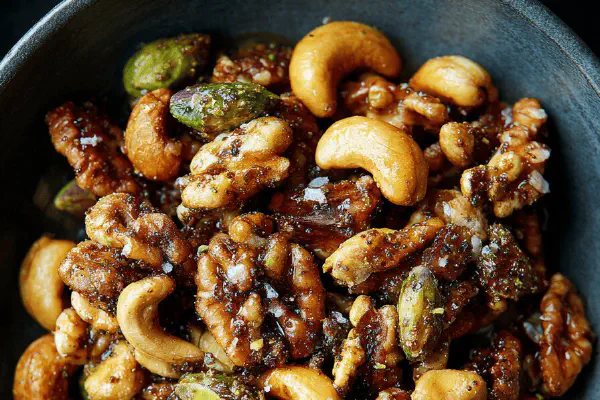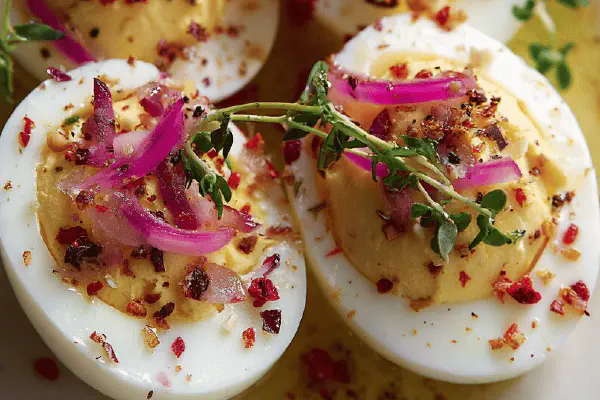Tangy Pickled Cauliflower

By Emma
Certified Culinary Professional
Ingredients
- 500 ml cauliflower florets (light, just trimmed, about one small head)
- 250 ml water
- 125 ml white wine vinegar
- 25 ml raw honey (about 1 2/3 tablespoons) substitute for sugar
- 15 ml coarse sea salt
- 5 ml black peppercorns
- 1 dried red chili, split (optional substitution for fresh chili)
- 1 slice fresh ginger (about 3 cm), peeled and sliced (replacing garlic)
- 1 bay leaf
- 5 ml coriander seeds (added twist)
About the ingredients
Method
- 1. Pack cauliflower florets tightly but gently into a clean 500 ml jar. Don’t smash; keep them airy so brine soaks in.
- 2. Combine water, vinegar, honey, and salt in a small saucepan. Add peppercorns, coriander seeds, dried chili, ginger slices, and bay leaf.
- 3. Bring mixture to a gentle boil; bubbles rising steadily, slight steam aroma. Simmer 6-8 minutes until sugars dissolve fully and spices bloom—the liquid will smell fragrant and slightly sharp.
- 4. Strain hot pickling liquid through fine sieve to catch solids; discard spices except bay leaf if you want milder flavor left behind.
- 5. Pour hot brine evenly over cauliflower in jar, leaving about 5 mm space under rim. Use a spoon to press cauliflower lightly so all bits soak, but don’t crush florets—want crunch preserved.
- 6. Seal jar immediately, trap rising steam inside. Let cool till barely warm on counter (around 1 hour).
- 7. Refrigerate overnight (minimum 20 hours) to let spicy warmth and acidity meld fully into crunch. Best flavor after 2-3 days but can start serving then.
- 8. Keep refrigerated up to 4 weeks. Check for any mold or cloudiness—normal cloudiness from fermentation is fine, but fuzzy mold means toss out.
- 9. When opening, tip jar slightly to smell sharp vinegar + subtle ginger. Textural test: bite cauliflower; should be firm, not mushy, with gentle snap.
- 10. Use as garnish, in salads, or alongside roasted meats or grains.
Cooking tips
Chef's notes
- 💡 Don’t pack florets too tight in jar—air gaps let brine flow and flavors settle better. Press carefully; want firmness but no smoosh. Watch bubbles during simmer—small steady rises mean spices bloom properly and sugars dissolve. Too fast boil dulls vinegar sharpness. Simmer slow, smell spike, then strain quick to catch seeds unless you want bay leaf floating for mild aroma. Leave 5 mm space top; steam expansion critical—overflow ruins jars and messes ferment drive.
- 💡 Honey swaps granulated sugar fine but tastes different—maple syrup or agave work but alter sweetness profile. Measure loosely; taste brine before pouring. Dried chili mellows heat over time; fresh burns sharper and less steady. Ginger replaces garlic here; adds heat without overpowering. Coriander seeds cracked lightly release oils fast when simmering; don’t overboil. Bay leaf adds depth but no bitterness if picked out before sealing.
- 💡 Water quality impacts fermentation—chlorine kills bacteria essential for fizz and tang. Filtered or bottled water best. Salt must be coarse sea salt, no iodized—iodine stalls ferment and leaves off flavors. Let cauliflower dry after washing; moisture on surface dilutes brine concentration. Press spoon lightly to soak florets evenly but keep crunch intact—too soft = loss of texture.
- 💡 Cool jars before pouring hot brine or warm jar gently; sudden heat shock risks cracks. Seal immediately with rising steam trapped inside—pressure jump jump aids acid merge. Let rest on counter till barely warm (around 1 hour), no rush cooling. Refrigerate min 20 hours; fizz starts faintly day 1. Cloudy brine normal; fuzzy mold or off odors = toss out. Keep clean rims; wipe dry before sealing to avoid seal break.
- 💡 Opening test: tip jar slightly for sharp vinegar and ginger aroma, bite cauliflower for snap firmness—soft = early or over-brined. Use as salad crunch or side with roasted meats, grains. Replace coriander with lemon zest or mustard seeds for alternate twist but keep bay leaf anchor herb. Experiment but watch brine: sharp, not bleach flavor, slightly sweet balance important.
Common questions
Can I use fresh chili instead of dried?
Yes but heat spikes loud early on, less steady warmth. Fresh results in sharper bite and faster intensity. Dried softens slow, mellows after hours in fridge. Depends what punch you want. Both valid but watch timing for best flavor.
How do I know when pickles are ready to eat?
Check after 20-24 hours chilling minimum. Aroma sharp vinegar with subtle ginger hit is good sign. Texture test needed—cauliflower should resist bite with snap. Too soft means over-brined or over-fermented. If in doubt keep cold longer or test small pieces.
My pickles turned cloudy—is that okay?
Cloudy brine normal from active fermentation bubbles, tiny yeasts and bacteria doing work. Fuzzy mold or weird smells no—discard if present. Always clean jar pre-use, wipe rim dry, tight seal helps prevent unwanted mold. Ventilation and no floating bits improve shelf life too.
How long to store pickled cauliflower?
Fridge best anywhere up to 4 weeks. Longer risks over-souring or texture loss—some get mushy after extended time. If jar smells off or mold shows must discard. Dark, cool place and sealed tight slows spoil. Opening slowly prevents fizz spill, aroma first test, then crunch test.



